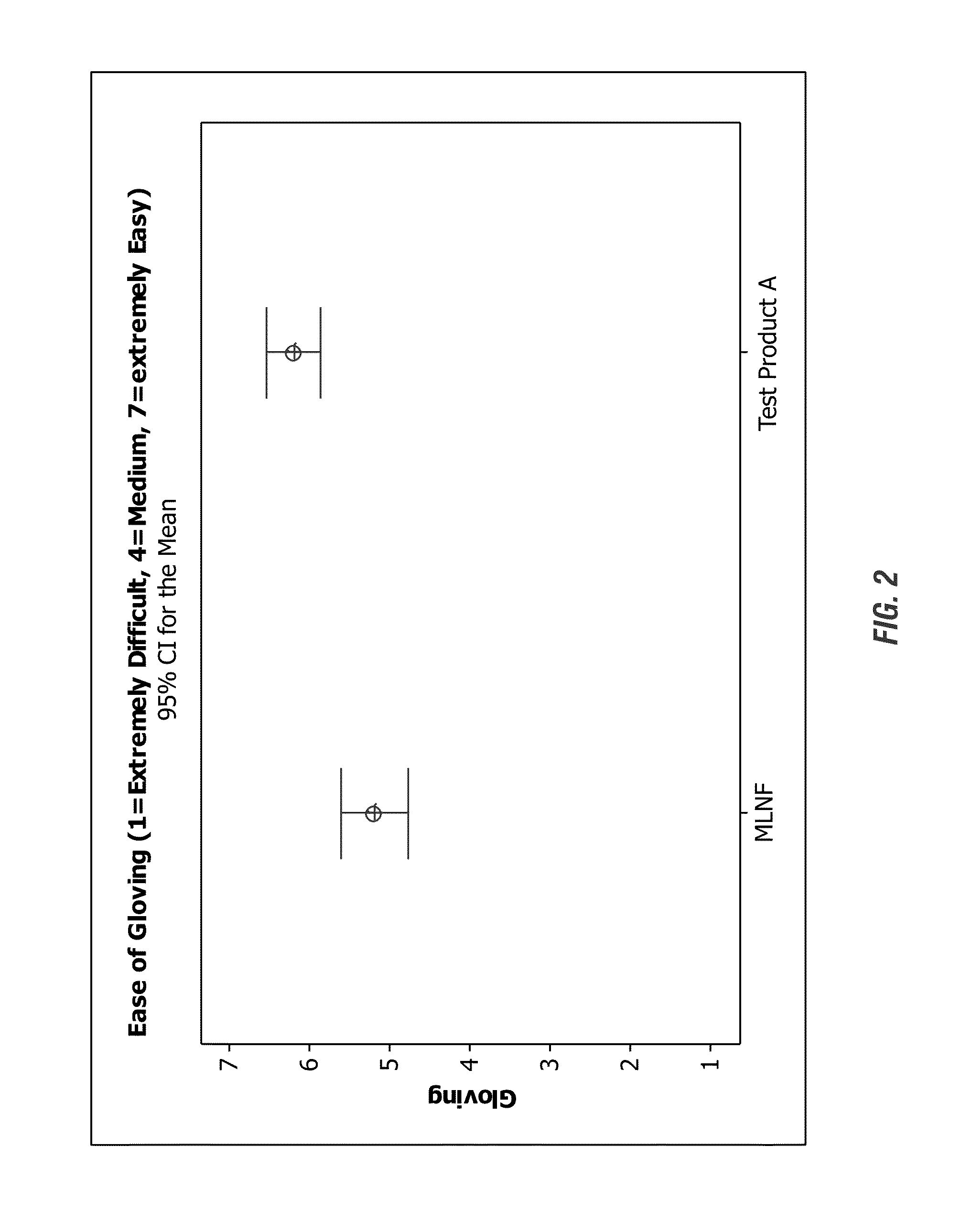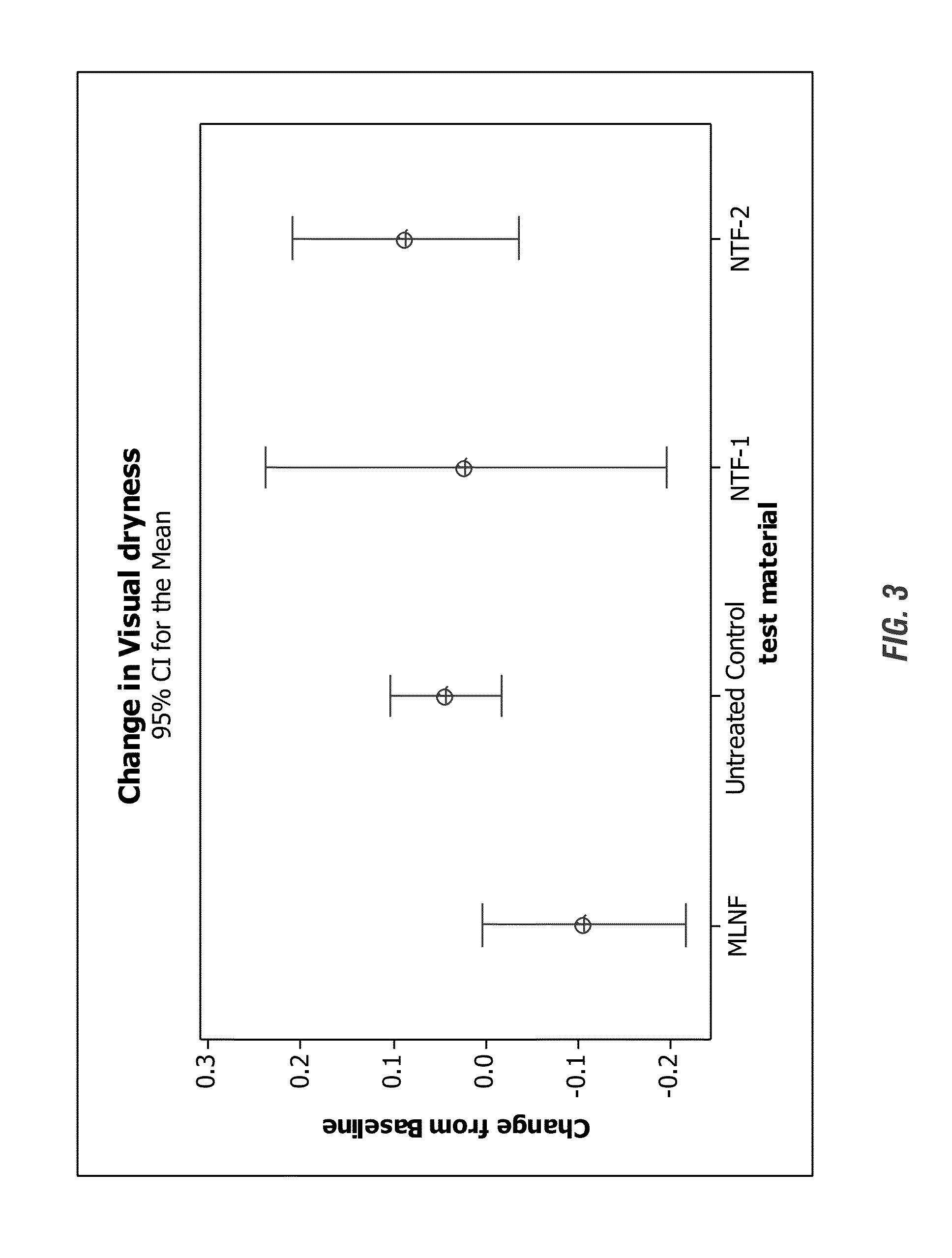Alcohol based sanitizer with improved dermal compatibility and feel
a technology of alcohol-based sanitizer and dermal compatibility, which is applied in the direction of dermatological disorders, organic active ingredients, drug compositions, etc., can solve the problems of reducing work efficiency, increasing the difficulty of applying gloves, and leaving undesirable sticky residues, so as to improve product stability and improve skin condition.
- Summary
- Abstract
- Description
- Claims
- Application Information
AI Technical Summary
Benefits of technology
Problems solved by technology
Method used
Image
Examples
example 1
Product Feel and Gloving
Healthcare workers were recruited to participate in the study, there were 45 total participants.
Products:
TEST PRODUCT A
MLNF=Market Leading Nourishing Foam
Testing Procedure:
[0097]1. The participants washed their hand with a bland hand soap and then thoroughly dried their hands with a paper towel.[0098]2. Participants then took one application of product from a touch free dispenser (˜0.7 mL) and rubbed their hands together until dry.[0099]3. Participants then recorded their observations on product feel during application and after feel.[0100]4. Two additional product applications were made ensure that the participant's hands were dry between applications.[0101]5. Following the third product application, the participants applied a nitrile glove to their non-writing hand.[0102]6. Once gloving was complete the participants recorded the ease of gloving on a 7 point scale and rated the product for overall product acceptance on a 9 point scale.[0103]7. Upon completin...
example 2
Forearm Controlled Application Test
Initial Test subjects: 45
Products:
[0109]Nourishing Test Formula 1 (NTF 1)[0110]Nourishing Test Formula 2 (NTF 2)[0111]MLNF=Market Leading Nourishing Foam
Treatments:[0112]Untreated Skin[0113]Nourishing Test formula 1 (NTF 1)[0114]Nourishing test formula 2 (NTF 2)[0115]Market Leading Nourishing Foam
Testing methods:
Corneometer (skin moisture)
Visual dryness (graded by an expert grader using magnification and a 5 point scale)
Tewa meter (Trans Epidermal Water Loss)
Procedure:
Sites were selected on the forearm of each test subject and 1.25″ circles were marked. The product application to the site was randomized at the beginning of the study. Baseline readings were made prior to product application.[0116]1. Product was applied to the appropriate position on the forearm twice a day. A minimum of three hours was maintained between treatments with one site left untreated.[0117]2. The two applications a day was conducted for four continuous days.[0118]3. On the...
example 3
Leg Controlled Application Test
Initial Test subjects: 38
Products:
[0131]Test Product A (Test product, SNF)[0132]Market Leading Foam Sanitizer, MLFS[0133]Antibacterial Foaming Hand Soap (AB Soap)
Treatments:[0134]Untreated Skin[0135]AB Soap and water three times per day[0136]MLFS 30 times per day with 3 AB Soap and water washes[0137]SNF 30 times per day with 3 AB Soap and water washes
Testing methods:
Corneometer (skin moisture)
Visual dryness (graded by an expert grader using magnification and a 5 point scale)
Procedure:
Subjects were selected for the study by having mildly dry skin as determined by an expert grader. Two sites on the back of each leg were marked. The product application to the site was randomized at the beginning of the study. Baseline readings were made prior to product application.[0138]1. Wash three sites with AB Soap and water, leave one site untreated.[0139]2. Apply 10 applications of product (either MLFS or SNF to their respective sites).[0140]3. Wash the three sites...
PUM
| Property | Measurement | Unit |
|---|---|---|
| wt. % | aaaaa | aaaaa |
| melting point | aaaaa | aaaaa |
| sanitizing composition | aaaaa | aaaaa |
Abstract
Description
Claims
Application Information
 Login to View More
Login to View More - R&D
- Intellectual Property
- Life Sciences
- Materials
- Tech Scout
- Unparalleled Data Quality
- Higher Quality Content
- 60% Fewer Hallucinations
Browse by: Latest US Patents, China's latest patents, Technical Efficacy Thesaurus, Application Domain, Technology Topic, Popular Technical Reports.
© 2025 PatSnap. All rights reserved.Legal|Privacy policy|Modern Slavery Act Transparency Statement|Sitemap|About US| Contact US: help@patsnap.com



